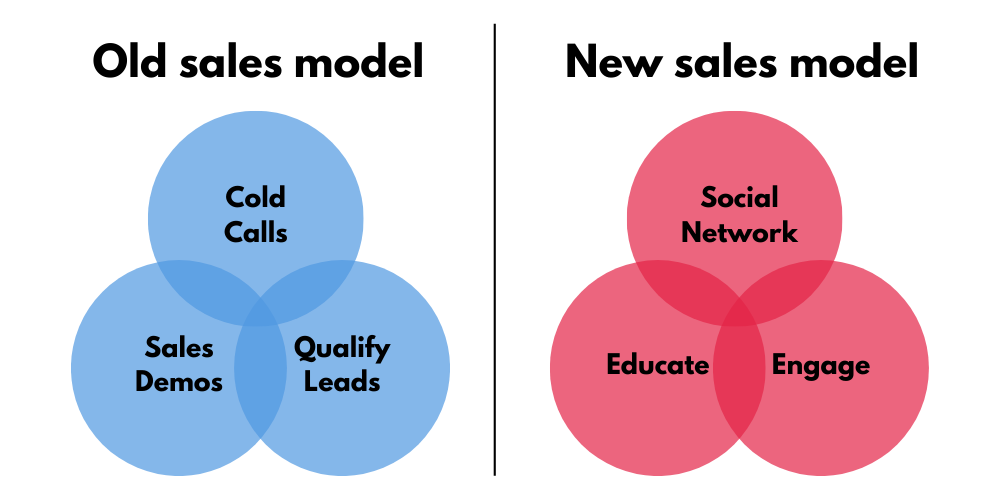Not everyone has a massive marketing budget or the time to launch strategic marketing campaigns.
The good news is that with a few simple steps, you can improve your ROI and build a bigger customer base.
We’ve put together the top five easiest ways to boost product visibility and online sales, along with powerful insights that will motivate you to start using these strategies today.
1. Social selling
Social selling is when a brand uses social media to connect with prospective customers, develop a relationship with them, and ultimately boost sales.
Businesses that do a good job of connecting with and engaging potential leads on social media reap a lot of benefits.
According to LinkedIn Sales Solutions’ internal data:
- Businesses that prioritize social selling are 51% more likely to reach their sales quota.
- Social selling leaders create 45% more sales opportunities than businesses with a low social selling presence.
- Businesses that sell on social media outperform 78% of businesses that don’t use social selling.
Clearly, social media has shifted the way many businesses do business. It’s not just about trying to close deals in the shortest time possible, it’s about connecting with your potential customers and providing valuable information so they can make informed buying decisions.

To sell on social media effectively, take the time to make meaningful interactions with your followers and present your brand as a valuable solution to a problem they face.
You can also increase engagement with your followers by adding a link in bio to your profile pages.
A link in bio is a single landing page that allows you to host a collection of URLs and then share that page through a single link.
Link in bios are especially important for Instagram and TikTik as those platforms don’t allow you to add clickable links to captions beneath posts.
Once you’ve created and added a link in bio page with all of your important URLs to your social media bio profiles, tell followers to check out your link in bio page in your post captions.
2. Email marketing
While social selling is rapidly changing the sales space, it’s important not to overlook your traditional email marketing efforts.
On average, email marketing produces a staggering ROI of $36 for every $1 spent.
With numbers like those, email marketing should be at the forefront of your marketing strategy and a major influence in how you can quickly increase online sales.
Email marketing does not require a ton of dedicated resources. To help you out, we’ve outlined the top tips below on how to set up an effective email marketing strategy.
1. Build a relevant email list
An email marketing campaign is only productive if you have a strong email subscriber list. To gain more emails, try adding segmented pop-ups to your website. Use pop-ups that can be triggered based on your audience. For example, triggers can set off different pop-ups based on your shopper’s location, browsing habits, or cart size.
2. Use email segmentation
Email segmentation means dividing email subscribers into smaller groups based on set criteria. Segmentation allows you to send more personalized emails to groups based on the information you have on them.
For example, if you had a free eBook on your website and 100 people signed up to have it sent to their email, then you could segment these emails and send more content-specific emails to them.
Other data points you can track include:
- Location
- Age
- Gender
- Occupation
- Sign-up source
- Industry
- Company position
- +more
Segmented email campaigns result in a 30% higher open rate and 50% higher click-through rate than non-targeted email campaigns. Additionally, segmented campaigns have a 760% increase in email revenue. So take the time to add multiple data points to your email list. It pays off!
3. Personalize your emails
Segmentation is just the first step in creating personalized email campaigns. Once you have segmented lists, you need to develop content that targets specific audiences.
Personalization can lead to a 10-15% increase in conversation rate and increases customer satisfaction rate by up to 20%.
To create personalized emails, use your segmented groups to send content based on their industry, job position, location, interests, etc.
It’s best to keep it simple in the beginning–what’s most important is that you start this process. You can always add more complexity, such as drip campaigns or split tests, once you get the ball rolling.
3. Mobile optimization
More and more people are using their mobile devices to make online purchases. In 2021, 72.9% of all online sales were made through mobile devices.
In other words, nearly 3/4th of online purchases are made on mobile devices.
That’s a lot.
So if you have a website that isn’t optimized for mobile, you’re potentially only making a quarter of what you could be.
The best way to make your website mobile-friendly is to view your site through the eyes of your customers.
When reviewing your website on your phone, ask yourself these three questions:
1. Does your site load quickly?
Almost half of all visitors to mobile websites will leave a site if it doesn’t load within three seconds. Yes, you read that right, three short seconds.
You can improve your page loading speed by choosing a performance-optimized hosting solution, compressing images, reducing redirects, and caching your web pages.
2. Is it easy to navigate?
Because mobile devices have smaller screens than desktops, you need to make sure your text is large enough to read without having to zoom in. You can also simplify your site menu to cut down on clutter.
3. Is it easy to take action?
People who visit your site on their mobile devices want to be able to quickly perform and move through actions, such as making a purchase or contacting you.
Minimize the number of steps it takes to complete a transaction or form and ensure that all buttons are clickable without having to zoom in.
Additionally, you can add mobile-first microsites or landing pages to your website to promote specific products or services.
Mobile-first pages are designed for mobile devices and are an easy way to boost your website’s mobile experience without redesigning your entire site.
Free mobile-first landing page tools like Amaze allow you to create interactive digital experiences and add them to your domain. You can also share your designs on social media to increase sales and product visibility.
You can try it for free here.
4. Positive online reviews
Online reviews can significantly improve your online sales.
In fact, there are so many staggering statistics about the impact of reviews that we’re just going to list a few here.
- A single review on your product page can increase conversion rates by 354%. (BazaarVoice)
- 89% of people read reviews before making a purchase. (Oberlo)
- Almost half (48%) of consumers go to a company’s website after reading positive reviews. (Vendasta)
- 91% of consumers aged 18-34 trust online reviews as much as recommendations from family and friends. (BrightLocal)
- 93% of consumers reported that online reviews affect their purchasing decisions. (Podium)
Positive reviews are among the strongest forces attracting new customers and hold a lot of influence over a consumer’s buying decisions.
So how can you get more positive reviews?
First, you want to make it easy for customers to post reviews. That means sending them direct links to your page on major review sites with a clear request asking them to post a review.
You can also offer an incentive for posting a review, such as a discount on future purchases, or share the reviews you currently have on social media to encourage other customers to write one up.
However, simply providing excellent customer service and a seamless checkout experience goes a long way. If you provide those, then positive reviews should follow.
5. Buyer personas
A buyer persona is a semi-fictional representation of your ideal customer. Building out buyer personas can help you better understand and relate to your audience.
And although it takes a little time and effort to research and develop personas, they pay off big time.
In fact, 93% of companies that exceed lead and revenue goals use buyer personas to segment their database. Additionally, persona-based content can increase customer engagement six-fold when targeting cold leads.
To create a buyer persona, look at your current customer base and write down any common traits and characteristics they share.
- What’s the age range and geographic region of most of your customers?
- Do your customers work at companies of a certain size?
- Do they have similar professional titles?
- What industry do your customers work in?
- What are their motivations and pain points?
Asking these questions will help you get a better idea of your typical customer. Once you’ve completed your research, you can place your data into a buyer persona template like the one below and reference it during your content creation process.
Credit: Cacoo
Buyer personas remind you to put your audience’s wants and needs at the forefront of your marketing and can help secure more sales through engaging content.
Conclusion
Implementing all of these marketing strategies to increase product visibility and online sales at once can be overwhelming. Try taking it one step at a time and work your way up to having all five strategies in place.
Ultimately, you need to make sure your company clearly communicates its value and solutions to common pain points to your target audience.
As Albert Einstein once said, “Strive not to be a success, but rather to be of value.”
When you can market your brand as a valuable resource, success is sure to follow.
If you want an easy way to promote your products or services online, be sure to sign up for a free, 15-day trial of Amaze here.
Amaze allows you to create landing pages with ease, including:
- Selling pages
- Link in bios
- Ad/jump pages
- Presentions
- +more!
Visit Amaze.co to learn more.





